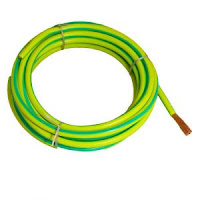 Earthing is the method of transmitting the instant electricity discharge directly to the ground through low resistance wires or electrical cables. This is one of the significant features of electrical networks. Because it builds the most eagerly accessible and hazardous power source much secure to utilize.
Earthing is the method of transmitting the instant electricity discharge directly to the ground through low resistance wires or electrical cables. This is one of the significant features of electrical networks. Because it builds the most eagerly accessible and hazardous power source much secure to utilize.
The process of earthing in case of short circuit condition, the electrical wire carefully removes the overflow of current and allows it to flow through the earth. All this occurs without unnecessary problems, only through resourceful and inexpensive manufacture, plan as well as arrangement!
Why Earthing is Required?
The main intention of electrical earthing is to keep away from the danger of electric shock due to the outflow of current from ground through the not preferred path as well as to make sure that the potential of a conductor does not increase with respect to the ground than its planned insulation.
When the metallic element of electrical machines approaches in contact by an existing wire, due to a breakdown of fixing the cable, the metal turn into charged and static charge collect on it. If someone contacts such an electric metal, then the outcome is a severe electric shock.
So finally We can conclude that life is random, and one should always get ready for unexpected circumstances. So buildings and electric appliances have to be grounded to transfer the electric charge directly to the ground. The main benefits of grounding include protection from over voltage, stabilization of voltage, and prevention form injury, damage, and death.
Components used in Electrical Earthing System
The main components used in earthing system mainly include earth cable, earthing joint (earthing lead), and earth plate
Earth Cable
The conductor is used to connect metallic parts of an electrical system like plug sockets, metallic shells, fuses, distribution boxes. Metallic parts of motors, transformers, generators, etc. the range of these conductors depend on the earth cable size used in the wiring circuit. The earth wire in the cross-sectional area must be less than the solid wire used in the electrical wiring system.
In general, the copper wire utilized as an earth continuity conductor size is 3-standard wire gauge (SWG). Ground wires which are smaller than 14-SWG should not be used. In some situations, copper strips are used instead of a bare copper conductor.
Earthing Joint
The ‘ground electrode’ as well as conductors fixing to the ‘ground continuity conductor’ is called earthing joint (earthing lead). The tip where the earthing joint connects the ground continuity conductor is known as connecting end. The lead of the ground must be low size, straight, & should include a minimum amount of joints. Although copper wires are usually used as grounding leads; whereas copper strips are selected for high fitting because it carries high fault current values due to its broad region.
Earth Plate
The last part of the electrical grounding system which is hidden underground and linked to the lead of grounding is known as the earth plate. Earth electrode is a pipe, plate or metallic rod, or plate; which has extremely low resistance for carrying the fault current to the ground safely.
It can be of iron or copper rod and must be placed in wet earth and in case the moisture content of earth is low then put some water in the earth plate. The earth plate is always placed in the vertical, and coat with salt and charcoal lime around the earth plate. This helps in protecting the earth plate as well as in maintains ground moisture around the earth plate. The earth plate must be placed four meters long for the better earthing.
Types of Electrical Earthing Systems
The process of Earthing or electrical grounding can be done in several ways like wiring in factories, housing, other machines, and electrical equipment. The different types of electrical earthing systems include the following.
Plate Earthing System
In this type of system, a plate is made up of copper or GI (galvanized iron) which are placed vertically in the ground pit less than 3 meters from the earth. For a better electrical grounding system, one should maintain the earth moisture condition around the plate earthing system.
Pipe Earthing System
A galvanized steel based pipe is placed vertically in a wet is known as pipe earthing, and it is the most common type of earthing system. The pipe size mainly depends on the soil type and magnitude of current. Usually, for the ordinary soil, the pipe dimension should be 1.5 inches in diameter and 9 feets in length. For rocky or dry soil, the pipe diameter should be greater than the ordinary soil pipe. The soil moisture will decide the pipe’s length to be placed in the earth. The pipe earthing diagram is shown below:
Rod Earthing System
This type of earthing system is similar to pipe earthing system. A copper rod with galvanized steel pipe is placed upright in the ground physically or using a hammer. The embedded electrodes lengths in the earth decrease the resistance of earth to a preferred value.
This is all about what is meant by earthing / definition of earthing and its types. From the above information, finally, we can conclude that the earthing system or electrical grounding system offers greater safety from electric shock for personal, equipment, buildings, etc. The ground sensitivity can be The earth resistivity can be affected by some issues like soil and climate, a condition of resistivity, moisture, melted salts, earth pit location, physical work, grain size effect, current magnitude, etc.





